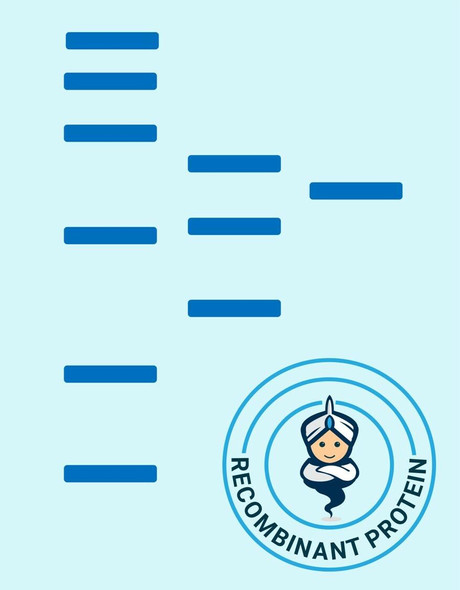Description
| Product Name: | Human UFM1 Recombinant Protein |
| Product Code: | RPPB5079 |
| Size: | 20µg |
| Species: | Human |
| Target: | UFM1 |
| Synonyms: | Ubiquitin-fold modifier 1, UFM1, C13orf20, BM-002, bA131P10.1. |
| Source: | Escherichia Coli |
| Physical Appearance: | Sterile Filtered colorless solution. |
| Formulation: | The UFM1 solution (1 mg/ml) 20mM Tris buffer (pH 8.0) and 10% glycerol. |
| Stability: | Store at 4°C if entire vial will be used within 2-4 weeks.Store, frozen at -20°C for longer periods of time. For long term storage it is recommended to add a carrier protein (0.1% HSA or BSA).Avoid multiple freeze-thaw cycles. |
| Purity: | Greater than 95.0% as determined by SDS-PAGE. |
| Amino Acid Sequence: | MGSSHHHHHH SSGLVPRGSH MSKVSFKITL TSDPRLPYKV LSVPESTPFT AVLKFAAEEF KVPAATSAII TNDGIGINPA QTAGNVFLKH GSELRIIPRD RVG |
UFM1 is a ubiquitin-like protein which is conjugated to target proteins by E1-like activating enzyme UBA5 and E2-like conjugating enzyme UFC1 in a manner equivalent to ubiquitylation. UFM1 localizes principally to the nucleus, but is also present in diffuse amounts in the cytoplasm. UFM1 is expressed in a variety of tissues, including kidney, brain, heart, liver and lung.
UFM1 Human Recombinant fused with a20 amino acid His tag at N-terminus produced in E.Coli is a single, non-glycosylated, polypeptide chain containing103 amino acids (1-83 a.a) and having a molecular mass of 11.1kDa. The UFM1 is purified by proprietary chromatographic techniques.
| UniProt Protein Function: | Ubiquitin-like modifier which can be covalently attached via an isopeptide bond to substrate proteins as a monomer or a lysine-linked polymer. The so-called ufmylation, requires the UFM1-activating E1 enzyme UBA5, the UFM1-conjugating E2 enzyme UFC1, and the UFM1-ligase E3 enzyme UFL1 (PubMed:15071506, PubMed:20018847). This post-translational modification on lysine residues of proteins may play a crucial role in a number of cellular processes. TRIP4 ufmylation may for instance play a role in nuclear receptors-mediated transcription (PubMed:25219498). Other substrates may include DDRGK1 with which it may play a role in the cellular response to endoplasmic reticulum stress (Probable). |
| NCBI Summary: | UFM1 is a ubiquitin-like protein that is conjugated to target proteins by E1-like activating enzyme UBA5 (UBE1DC1; MIM 610552) and E2-like conjugating enzyme UFC1 (MIM 610554) in a manner analogous to ubiquitylation (see UBE2M; MIM 603173) (Komatsu et al., 2004 [PubMed 15071506]).[supplied by OMIM, Dec 2008] |
| UniProt Code: | P61960 |
| NCBI GenInfo Identifier: | 7705300 |
| NCBI Gene ID: | 51569 |
| NCBI Accession: | NP_057701 |
| UniProt Secondary Accession: | P61960,Q14346, Q5VXS0, Q6IAG6, Q9CPX2, Q9NZF2, |
| UniProt Related Accession: | P61960 |
| Molecular Weight: | 11.1 kDa (103aa), confirmed by MALDI-TOF |
| NCBI Full Name: | ubiquitin-fold modifier 1 isoform 1 |
| NCBI Synonym Full Names: | ubiquitin fold modifier 1 |
| NCBI Official Symbol: | UFM1�� |
| NCBI Official Synonym Symbols: | BM-002; C13orf20�� |
| NCBI Protein Information: | ubiquitin-fold modifier 1 |
| UniProt Protein Name: | Ubiquitin-fold modifier 1 |
| Protein Family: | Ufm1-specific protease |
| UniProt Gene Name: | UFM1�� |






